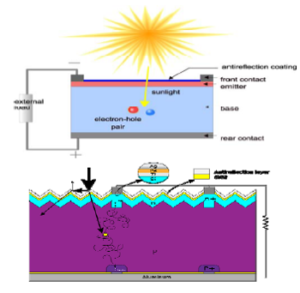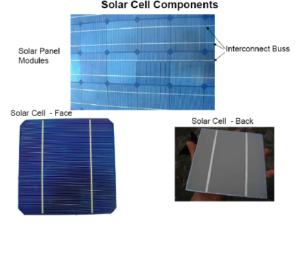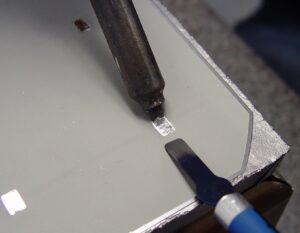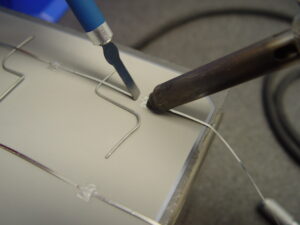In recent years, active solders have made their way into use in solar panel manufacture. To understand where S-Bond solder alloys are being used one has to understand the solar panel construction. Solar panels consist of arrays of solar cells, soldered together. A solar cell consists of three basic elements, top contact, base and rear contact, as shown in Figure 1. From the back of each solar cell, electrical contact needs to be made between these surfaces to close the circuit and provide an electron path as photons emit electrons in the semiconductor polysilicon photovolatic (PV) cell which migrate to the back of the exposed cell surface, as illustrated.
 Figure 1. Illustration of solar cell.
Figure 1. Illustration of solar cell.
Electrical current is carried by buss strips (copper or silver) deposited or soldered to the front and back contacts. In today’s photovoltaic (PV) technology, the back plane is made via depositing and diffusing an aluminum powder suspension, shown in Figure 2. The Al-layer is the darker gray layer made up of sintered aluminum powder particles that, during sintering, interdiffuse aluminum (Al) into silicon to create a conductive back contact layer that collects the electrons emitting from the PV Si-cells. In conventional soldering of rear contact busses (tabs), silver strips for tab contact areas have been required to create a solderable interface to the Si back contact. Soldered busses (copper strips) connect one cell to create a array of electrically connected cells to form a solar power module, as shown in Figure 2.
 Figure 2 String of solar cells connected via soldered copper strip. Single solar cell face and back showing aluminized panel.
Figure 2 String of solar cells connected via soldered copper strip. Single solar cell face and back showing aluminized panel.
S-Bond Technologies has worked with several manufacturers to develop a process to bond copper “tabbing” conductors to the back cell aluminized polysilicon rear contact. Active soldering eliminates the need for the pre-applied silver contact layer and flux, thus lowering cost. Additionally, active solders directly bond to the aluminized silicon contact lowering the contact resistance at the tab contact point, resulting in decreased electrical losses which increases cell/module power conversion efficiency. Direct bonding also creates stronger soldered tab connections, increasing the robustness of the soldered solar panels. All these factors combine to make active soldering an attractive alternative manufacturing process for solar panels.
 Figure 3 illustrates how SBT’s active solders bond the electrical buss directly to the solar cell using ultrasonic soldering bonding to wet the solder directly to the aluminized back solar cell. Figure 3 shows the S-Bond solder being applied in preparation for the tab bonding step.
Figure 3 illustrates how SBT’s active solders bond the electrical buss directly to the solar cell using ultrasonic soldering bonding to wet the solder directly to the aluminized back solar cell. Figure 3 shows the S-Bond solder being applied in preparation for the tab bonding step.
Figure 3. Illustration of active solder ultrasonic soldering bonding process creating a soldering pad on the aluminized back-plane a solar cell.
In the final step, a solder plated copper buss is then soldered directly to the active solder pad. Figure 4 show the ultrasonic soldering of the plated buss to the back of the aluminized solar call.
 Figure 4. Ultrasonic soldering of tabbing wire to the back of the aluminized solar panel.
Figure 4. Ultrasonic soldering of tabbing wire to the back of the aluminized solar panel.
This simplified active soldering process is now being adopted by solar panel manufacturers for lower costs and increased panel efficiency.
Contact us to see how active solder technology can be used to improve your manufacturing process. Click the link for a copy of S-Bond Technologies recent publication on solar panel soldering.

One Response
Hello,
I regularly solder solar cells using traditional methods of soldering. I have perused the brief article about your method of soldering and would like more information. Specifically, can this process be used by the DIY (Do-It-Yourself) enthusiast? Or is this process limited to highly automated systems of production?
Thank you,
Patrick Minns